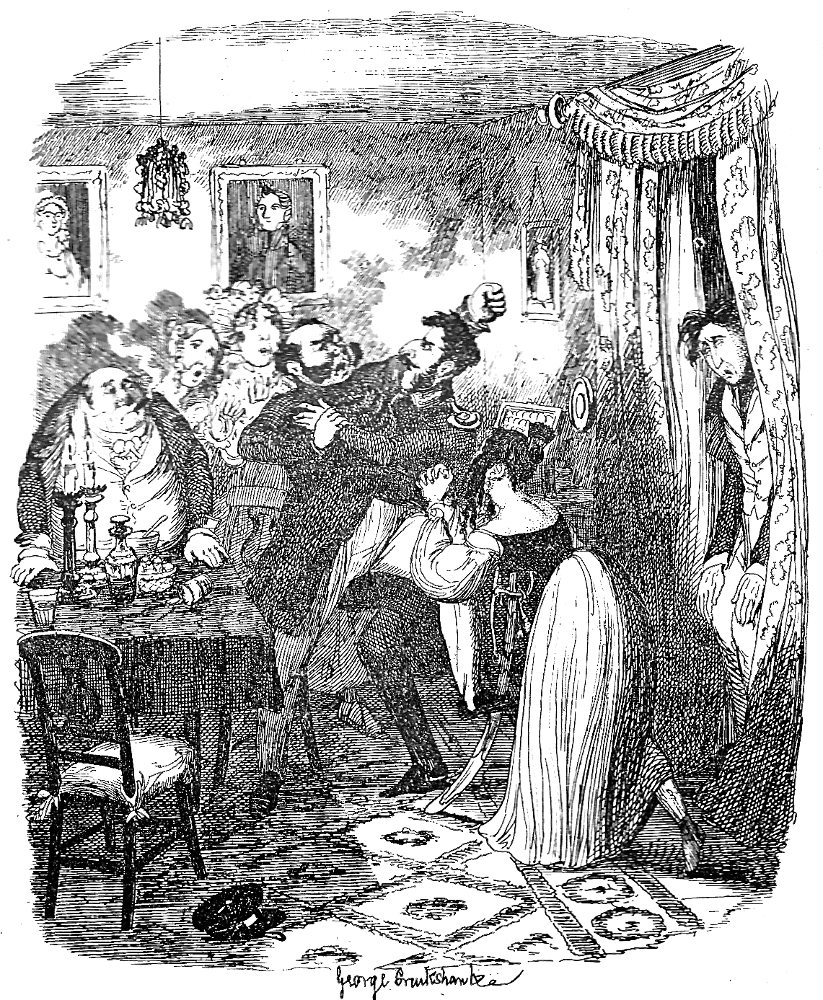
"So exactly the air of a marquis," said the military gentleman. (wood-engraving). 1876. 10.7 cm high x 13.8 cm wide, framed. — Fred Barnard's response to the theatrical illustrations of both George Cruikshank and Robert Seymour. Whereas both earlier illustrators had provided somewhat farcical "action" realisations of the short story's climax, Barnard does not suggest what will transpire. Cruikshank provided a single illustration when the story was re-printed by Chapman and Hall in the "Tales" section of Sketches by Boz in 1839. Perhaps not wishing to undercut the comic revelation scene upon which the story closes in an imitation of French farce, Barnard merely shows the scene in which Captain Waters, his wife Belinda, and their friend Lieutenant Slaughter first meet the Tuggses on the deck of the Ramsgate steamer. That the awkward Cymon looks nothing like an aristocrat in manner or clothing should suggest to the astute reader that Belinda is flattering the noveau riche family as part of some sort of confidence scheme.
Scanned image and text by Philip V. Allingham. [You may use this image without prior permission for any scholarly or educational purpose as long as you (1) credit the person who scanned the image and (2) link your document to this URL in a web document or cite the Victorian Web in a print one.]
Passage Illustrated
"Walter, my dear," said the black-eyed young lady, after they had sat chatting with the Tuggses some half-hour.
"Yes, my love," said the military gentleman.
"Don't you think this gentleman (with an inclination of the head towards Mr. Cymon Tuggs) is very much like the Marquis Carriwini?"
"Lord bless me, very!" said the military gentleman.
"It struck me, the moment I saw him," said the young lady, gazing intently, and with a melancholy air, on the scarlet countenance of Mr. Cymon Tuggs. Mr. Cymon Tuggs looked at everybody; and finding that everybody was looking at him, appeared to feel some temporary difficulty in disposing of his eyesight.
"So exactly the air of the marquis," said the military gentleman.
"Quite extraordinary!" sighed the military gentleman's lady.
"You don't know the marquis, sir?" inquired the military gentleman.
Mr. Cymon Tuggs stammered a negative.
"If you did," continued Captain Walter Waters, "you would feel how much reason you have to be proud of the resemblance — a most elegant man, with a most prepossessing appearance."
"He is — he is indeed!" exclaimed Belinda Waters energetically. As her eye caught that of Mr. Cymon Tuggs, she withdrew it from his features in bashful confusion.
All this was highly gratifying to the feelings of the Tuggses; and when, in the course of farther conversation, it was discovered that Miss Charlotta Tuggs was the fac-simile of a titled relative of Mrs. Belinda Waters, and that Mrs. Tuggs herself was the very picture of the Dowager Duchess of Dobbleton, their delight in the acquisition of so genteel and friendly an acquaintance, knew no bounds. Even the dignity of Captain Walter Waters relaxed, to that degree, that he suffered himself to be prevailed upon by Mr. Joseph Tuggs, to partake of cold pigeon-pie and sherry, on deck; and a most delightful conversation, aided by these agreeable stimulants, was prolonged, until they ran alongside Ramsgate Pier. — "Tales, " Chapter 4, "The Tuggses at Ramsgate," p. 161.
Pertinent illustrations from the 1836 Library of Fiction and the 1839 edition



Left: Robert Seymour's realisation of the scene in which the plebeian Tuggses encounter their new "superior" friends on the beach, Captain and Mrs. Waters Greeting The Tugg's Family on Ramsgate Sands (March 1836). Centre: Robert Seymour's realisation of the climactic comic scene in which the wrathful Captain pretends to be affronted by Cymon's attempting to engage his wife in an affair, Vengeance of Captain Walter Waters and Lieutenant Slaughter. Mr. Cymon Tuggs discovered behind the curtains, at the Waters's Lodgings (March 1836). Right: George Cruikshank's sole illustration for the same sketch, with the Cymon, just revealed as hiding behind the curtain, watching the Captain wrestle the Lieutenant for his sabre, The Tuggses at Ramsgate (1839). [Click on the images to enlarge them.]
References
Ackroyd, Peter. Dickens: A Biography. London: Sinclair-Stevenson, 1990.
Bentley, Nicholas, Michael Slater, and Nina Burgis. The Dickens: Index. Oxford: Oxford U. P., 1990.
Cohen, Jane Rabb. Part One, "Dickens and His Early Illustrators: 1. George Cruikshank. Charles Dickens and His Original Illustrators. Columbus: Ohio University Press, 1980. Pp. 15-38.
Davis, Paul. Charles Dickens A to Z. The Essential Reference to His Life and Work. New York: Checkmark and Facts On File, 1998.
Dickens, Charles. "The Tuggses at Ramsgate," Chapter 4 in "Tales," Sketches by Boz. Illustrated by George Cruikshank. London: Chapman and Hall, 1839; rpt., 1890. Pp. 251-267.
Dickens, Charles. "The Tuggses at Ramsgate," Chapter 4 in "Tales," Sketches by Boz. Illustrated by Fred Barnard. The Household Edition. London: Chapman and Hall, 1876. Pp. 159-168.
Dickens, Charles. "The Tuggses at Ramsgate," Chapter 4 in "Tales," Sketches by Boz. Illustrated by Harry Furniss. The Charles Dickens Library Edition. London: Educational Book Company, 1910. Vol. 1. Pp. 322-342.
Hawksley, Lucinda Dickens. Chapter 3, "Sketches by Boz." Dickens Bicentenary 1812-2012: Charles Dickens. San Rafael, California: Insight, 2011. Pp. 12-15.
Schlicke, Paul. "Sketches by Boz." Oxford Reader's Companion to Dickens. Oxford: Oxford U. P., 1999. Pp. 530-535.
Slater, Michael. Charles Dickens: A Life Defined by Writing. New Haven and London: Yale U. P., 2009.
Last modified 16 April 2017